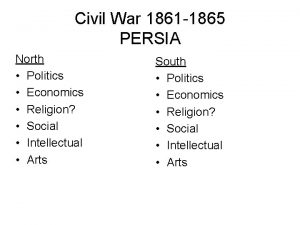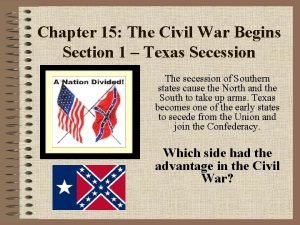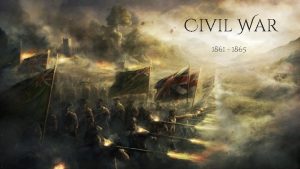Slavery and the Civil War Slavery Comes to









- Slides: 9

Slavery and the Civil War

Slavery Comes to America The taking and holding of slaves has occurred in human history for thousands of years. • Ancient Greece, Rome and Egypt • African and Muslim states � The Atlantic Slave trade began in earnest around 1502. • Portugal began buying slaves from Africans and transporting them to new colonies in the New World. � Eventually all the major European powers joined in • Spain • France • England • The Netherlands �

Slaves in North America � The Atlantic slave trade was well established by the time English settlers came to Virginia. � A shortage of labor drove the desire for slaves • Native peoples were too susceptible to European diseases • Indentured servants weren’t efficient • African slaves proved the most effective and lucrative � Lots of land meant that even poor immigrants could be land holders soon and would need labor

Triangle Trade � Three continents were involved in the slave trade • Europe • The Americas • Africa � Europe: Manufactured goods (guns, cloth, iron) � The Americas: Commodities (Sugar, molasses, rice, silk, cotton) � Africa: Human labor and resources (slaves, gold, spices, hardwoods)

The Middle Passage � The voyage from Africa to The Americas became known as “The Middle Passage” � Conditions on ships were extremely harsh • Nearly 13 percent perished on the journey � estimated that Europeans were bringing an 80, 000 slaves to the Caribbean yearly. • About 500, 000 Africans were imported into what is now the U. S. between 1619 and 1807 • The City of Nashville has about 600, 000 � Slaves worked in all facets of life in the North and South • Slavery was outlawed in most of the North by 1800.

Life of a Slave Its difficult to paint one picture of “slave life” � Slave labor could be divided into two categories: • House work �Cooks �Maids �Nannies �Drivers �Butlers • Field work �Crop cultivation and processing �Butchers �Blacksmiths �

African-American Slave Culture � Africans brought to America came from rich cultural traditions • Many customs stayed with slaves particularly in the early colonial days. • Archeologists have found drums and other musical instruments that were similar to ones found in Africa � African slaves were forbidden to learn to read or write • The bible offered an opportunity to gain some education � Women would make beautiful quilts, baskets and rugs � Men would work with iron or wood

African-American Slave Culture � Many foods that we consider “southern” were foods passed down from African culture • Slaves cooked meals and they became popular in white culture � Music was a big part of slave life • Field workers would sing during the day • Slaves sang biblical songs • On Sundays slaves were allowed, even encouraged, to sing and play music. • The creation of “negro spiritual”

Slaves Revolt � Despite white fears, there were very few instances of slave revolts • Nat Turner • Stono Rebellion � Slaves resisted in other ways • Work stoppage • Broken tools • Creating lives for themselves • Spirituals
 Chapter 16 lesson 2 challenges to slavery
Chapter 16 lesson 2 challenges to slavery Civil war first modern war
Civil war first modern war Civil rights and civil liberties webquest
Civil rights and civil liberties webquest First comes love, then comes marriage
First comes love, then comes marriage Cotton diplomacy
Cotton diplomacy Unit 4 civil war and reconstruction
Unit 4 civil war and reconstruction Civil war and reconstruction study guide
Civil war and reconstruction study guide Civil war advantages and disadvantages chart
Civil war advantages and disadvantages chart States rights
States rights North and south states civil war
North and south states civil war
















